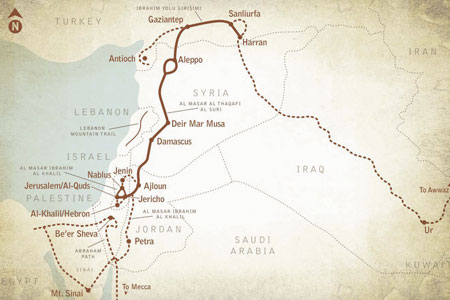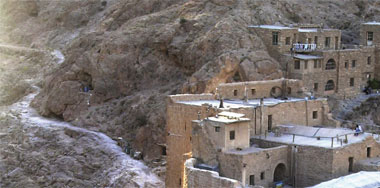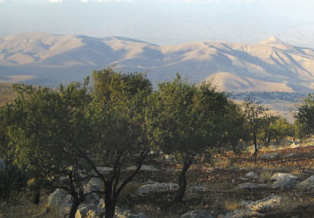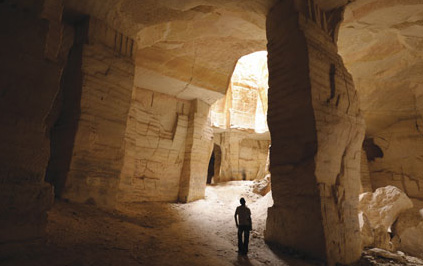
The Trail of the Patriarch
Issue 86 November 2011
Abraham, the father of nations, the perfect monotheist, who made the ultimate sacrifice, was a well-travelled man. Nafe Anam follows his path.
Over four thousand years ago Abraham roamed the Middle East. The man who is the historical departure point for over three billion people on earth is also their historical origin. His travels, documented in the Qur’an, Torah and the New Testament, as well as in folklore, tells the story of a remarkable journey crisscrossing the world’s conflict regions of today, as well as the world’s graveyard of civilisations. His journey, mapped out in today’s geo-political map, covers Iraq, Turkey, Jordan, Syria, Palestine, Israel, Egypt and Saudi Arabia.
To trace Abraham’s exact footsteps is a near impossible task. The three religious texts do not agree, and at times contradict each other. Local lore narrates a mythical journey, unsupported by archaeological facts. Despite this, it is possible to travel, as he did, from ancient towns, through deserts, and to walk between walls built in antiquity, while listening to words from long forgotten tongues. One project that seeks to do just that is the Abraham’s Path Initiative (API). The brainchild of Dr William Ury, the project was born out of a desire to use Abraham as a unifying figure to share the world’s heritage. “The route of Abraham is something that has existed for four thousand years and we are just dusting off the footprints,” explains Joshua Weiss, managing director at the Abraham’s Path Initiative. “We went through the religious text. We also found local lore that existed in the towns and villages. You can’t be 100 percent sure of the route, but quite likely it was not linear. Without any navigation tools there must have been lots of going back and forth,” suggests Weiss. Given the borders and the modern realities on the ground, the path mapped out by the organisation is a 350km long non-contiguous path, touching the most relevant historical sites as well as navigating through the most beautiful landscapes of the Holy Land.
Abraham is a theological figure found in three major religions, but the region itself also provides a rich tapestry of human faith, culture and society. The journey of Abraham is a map through the core of human history. To walk upon the path he trod is to follow the footsteps of humankind, through the ideas, values, beliefs and cultures that have shaped us and which continue to shape us today. The nature of communities and conflicts crossed by the path adds greater importance to the power of storytelling, of walking and of landscapes to unify divided peoples by pointing out the obvious fact of history: for over four millennia they have shared rugged hilltops, inspired by spiritually nourishing landscapes, and bestowed with a line of prophets unmatched by any other geographical place on earth.

Abraham’s path begins in the most southern part of Turkey. In the Biblical town of Edessa, now Sanliurfa, local tradition holds that Abraham was born inside a nearby cave, although Ur in Mesopotamia is the more likely candidate for Abraham’s birth city. In Sanliurfa there is also the legend of the Pool of Sacred Fish where Abraham was thrown into the fire by Nimrod. The pool can be found surrounded by a beautiful garden in the courtyard of the mosque of Halil-ur-Rahman, built by the Ayyubids in 1211. Local mythology dictates that fish populations flourish in the courtyard and if you are lucky to spot a white fish, then the doors to paradise will open for you.
The next major stop on the path is the ancient Biblical city of Harran where Abraham received the call from God to leave his home and ‘go forth’. In the Biblical story, Harran is where Terah, his son Abraham, his grandson Lot, and Abraham’s wife Sarah settled while en route to Canaan, after migrating from Ur (Genesis 11:26–32).
As with any significant place on Abraham’s route, there are also other historical treasures along the way. In the outskirts of Sanliurfa lies Gobekli Tepe, the oldest known temple complex in the world dating from the 10th millennium BCE. It is an astonishing archaeological site, even more so given that Neolithic man had only primitive tools to quarry, carve and to transport uphill. Each structure encloses two pillars placed in circles supporting the roof while the walls are decorated with animal and abstract pictograms. The floor is plain, only interrupted by stone benches placed in between pillars. Another ruin nearby is the ancient city of Segmater on the old Silk Road, a centre of the pagan cult of the Moon God. There is also Suyab City, the reputed home of the Prophet Jethro, the great grandson of Abraham.
Leaving Turkey, the path now winds through Syria. The ancient town of Aleppo, the most populous city in the country, where Abraham gave milk to passing travellers—giving the city its original Abrahamic name Halab. The city is a museum of historical quarters ranging from classical Hellenistic era through to the medieval and to the early modern Ottoman. Amongst the many historical ruins it also contains the crumbling citadel of Aleppo, considered one of the oldest and largest castles in the world. Usage of the citadel hill dates back at least to the middle of the third millennium BCE. Another significant stop in Abraham’s journey is of course the capital, Damascus, where he is reputed to have stayed. Damascus is considered to be one the oldest continually inhabited population centres of the world. In its vicinity is the beautiful Umayyad Mosque, which houses the tomb of Salahuddin (Saladin) and, as it is a former Christian basilica, also has the remains of John the Baptist.
 Other historical sites along the path worthy of a visit include the ancient city of Bosra. At its height, the capital of the Roman province of Arabia was a stopover on the caravan route to Makkah. There are also the Forgotten Cities, an impressive and wonderful array of ruins, numbering seven hundred Romano-Byzantine settlements. The UNESCO World Heritage site Krac des Chevaliers is nearby. It is an example of the finest medieval military architecture in the Middle East. There is also the Deir Mar Musa Monastery in the desert, dating from the sixth century and Ma’loula, a small mountain village where Aramaic, the language of Jesus, is still spoken.
Other historical sites along the path worthy of a visit include the ancient city of Bosra. At its height, the capital of the Roman province of Arabia was a stopover on the caravan route to Makkah. There are also the Forgotten Cities, an impressive and wonderful array of ruins, numbering seven hundred Romano-Byzantine settlements. The UNESCO World Heritage site Krac des Chevaliers is nearby. It is an example of the finest medieval military architecture in the Middle East. There is also the Deir Mar Musa Monastery in the desert, dating from the sixth century and Ma’loula, a small mountain village where Aramaic, the language of Jesus, is still spoken.
On its way to Palestine, the path crosses through Jordan with sites linked to some of Abraham’s significant descendants. Tel Mar Elias, a beautiful hilltop Byzantine church is believed to be the birthplace of the Prophet Elijah. Mount Nebo is where Moses is said to have viewed the land of Canaan and is also reported to be buried. Here remains a fourth century church and monastery with six tombs hollowed from the natural rock beneath the mosaic-covered floor of the church. These mosaic floors are corresponding remnants from different historical periods, the earliest being a panel with a braided cross presently placed at the east end of the south wall. The mount provides a stunning panoramic view of the Holy Land and the Jordan Valley. Other sites of interest include a 12th century Arab castle, Ajloun. This huge fortress, built by Salahuddin’s army, is considered to be one of the very few constructed to provide protection against the Crusades. Finally, there is the Bethany on the river Jordan where John the Baptist is believed to have baptised Jesus.
The path reaches its climactic finish among the sites found in Palestine—a sacred place for three religions. It is unsurprisingly marked with historical grandeur and legacy. Hebron, the largest city in the West Bank, is home to the Tomb of Patriarchs, where Abraham and his wife Sarah are buried. The Arabic name for the town is Ibrahim al-Khalil, denoting Abraham the Friend (of God). According to Genesis, Abraham purchased a cave and the field surrounding it from Ephron the Hittite to bury his wife Sarah. Isaac, Rebecca, Jacob and Leah and he were later buried in the cave. In the surrounding area there are now churches, synagogues and mosques. The Isaac Hall is now the Ibrahimi Mosque, and the Abraham Hall and Jacob Hall serve as a synagogue. The original caves consisting of the tombs lie underneath Ibrahimi Mosque. The whole complex is a labyrinth of historical treasures. It seems every spot has religious significance and in every turn history was made. Another famous town is of course Bethlehem, the birthplace of Jesus. However, it is also the place where the Biblical matriarch Rachel died and was buried ‘by the wayside’. There is also a place revered by the Russian Orthodox Church where it is believed Abraham pitched his tent. The Oak of Sibta, a five thousand year old oak tree, lies one and a quarter mile south-west of Mamre. There are also a few sites that now lie within Israel. They are mainly connected to the Negev Desert. Tel Be’er Sheva is an ancient oasis in the desert where Abraham made his covenant and where, with Isaac, he built a well. Tel Arad is a Bronze Age settlement with a ruined citadel and sanctuary from the time of David.
The original home of Abraham is considered to be Ur in Iraq. His total journey measures hundreds and thousands of miles. He walked and wandered in faith and in complete trust of God. He visited villages, towns and cities and in each of these places he found stories, cultures, beliefs and conflicts—people with their own history and legacy. In many ways walking the path in the modern world is no different. The mix of diverse and differing people would be a familiar sight to Abraham. This Man, this beloved friend of God, can be seen as the departure point for three religions. Yet he is the father—revered by all. API’s Josh Weiss adds that, “There is a story recounted that when Abraham died, and he was to be buried in Hebron, Ismail and Isaac came together, and there was what some would consider an act of reconciliation. You can see what happens in the Middle East as a family conflict.” Perhaps this wandering month-long walk, upon the father’s path, will aide that reconciliation process.

Bookmark this |
|
Add to DIGG |
|
Add to del.icio.us |
|
Stumble this |
|
Share on Facebook |
|
Share this |
|
Send to a Friend |
|
Link to this |
|
Printer Friendly |
|
Print in plain text |
|


Comments
0 Comments